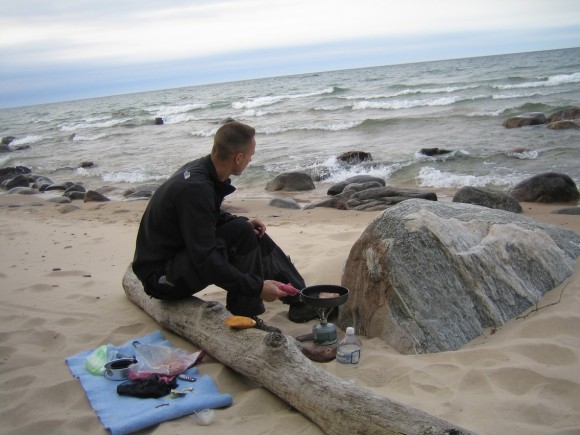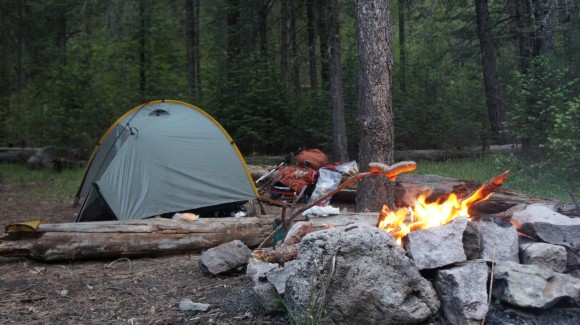Backpacking Without A Stove

I want to talk a little bit about backpacking without a stove. I know some of you probably think hiking without one is inconceivable, but I’m going to try and convince you that going stoveless isn’t the end of the world. In fact, there are some very appealing benefits to planning a hike without one.
First let’s state the obvious: not carrying a stove means less weight. You don’t have to carry the stove, fuel, and a lot of the cookware you might normally take. The stove itself isn’t much of a weight or size issue these days, but the fuel and cookware are more bulky. Now, some may argue that the food you carry to replace dehydrated foods will likely be heavier, which it is. The question then becomes if the difference in weight between the foods is less than the weight savings from dropping the stove/cookware/fuel. It would all depend on how much dehydrated and cook type foods you bring as a percentage of your total food bag, how long the hike is, and exactly which foods you bring. However, the weights savings ought to outweigh the extra weight of the additional food weight. This is especially true on shorter hikes. Let’s say you drop 2 pounds between the stove/cookware/fuel and add half a pound of food per day. As you can see, a hike of 3 days or less will see a weight savings from dropping the stove & other gear, the fourth day would be even, and anything after day 4 would mean carrying additional food weight that you wouldn’t be carrying when cooking with the stove. Of course, your numbers will be different, so the weight savings may be more or less depending on your situation.
Another huge benefit to a cookless food strategy is being less dependent on water sources. Dehydrated foods require water, and unless you are near a water source, that means that water must come from your drinking water supply. In many places this is not an issue, but for those hiking in arid environments, this can be a nuisance. For instance, when hiking in Big Bend National Park a few years ago, there was only ONE water source along my 40 mile trek. I was able to cache some water at one point along the trail before starting the hike, but I still started with a 3 day supply of water, resulting in a 60 pound pack. That’s heavy! Imagine how much extra water you’d need to carry to facilitate cooking and cleaning. For me, that’s an extra hassle that is just not worth it. By eliminating meals that require cooking, I was able to avoid using my precious drinking water for cooking and cleaning. I have even heard of some parks prohibiting the use of stoves altogether during extremely dry conditions to prevent fires, so you may be forced to go without one at some point anyways. Camping near water is always preferable, but let’s face it; sometimes it’s just not feasible. Bringing cookless meals can reduce one’s reliance on water sources near camp.
Cooking also takes time. Depending on your hiking style, time of year (daylight available), and mileage covered for the day, you might not have much time after getting to camp. Spending what little time you may be left with at camp by cooking and cleaning is not at the top of my list.
If you insist on cooking, you can still get away with leaving the stove and fuel behind by cooking over a fire, if that’s allowed and feasible where you are going. Some campsites that have the metal rings for firepits also have an area on the side to set a pot or pan for cooking. If not, you can cook in other ways. The first thing that comes to mind is foods like hot dogs, italian sausage and bratwurst… these can be cooked on sticks over the fire. If you freeze meats like italian sausage or hamburger/steak, you can eat them on the first or second night if the outside temperature is not too warm and you manage to keep them well insulated in your pack during the day. Hot dogs can manage a few days in the pack without refrigeration. Foods like pre-cooked bacon can be wrapped in aluminum foil and set over coals to cook. I’m sure most people who use a stove aren’t cooking meat though, most likely one of those nasty Mountain House meals or something. A pot could also be used over the fire, supported by a stick if you have the type of pot with the handle looped over the top and not on the side.
I have read about many thru hikers who got tired of the cooking routine every night and ended up ditching their stove at some point along their hike, and became very fond of a cookless meal strategy. Going stoveless is not for everyone though. Some people cannot live without coffee or other warm drinks in the morning/evening, don’t like to eat too much “snack” foods, or simply don’t mind that extra hassles of carrying a stove and everything else that comes with cooking. Backpacking without a stove has worked great for myself and many others, but everyone is different. Just realize that it is a viable option, and not a bad one at that.
Here’s a list of food items to get you started in the right direction:
Quaker natural granola cereal (mix with milk or eat by the handful)
Sesame sticks
Metrx Big 100 meal replacement bars (protein bars)
Jerky
Hunter’s sausage
Dried fruit (apples, strawberries, pineapple, mango, cranberries, etc)
Pepperoni
Salami
Cheese (harder cheeses last longer, like sharp cheddar)
100% whole wheat bread, tortillas, flatbread, bagels
Pre-cooked bacon
Summer sausage
Hot dogs
Fresh meats (keep frozen in cooler until you get to trailhead)
Powdered milk
Whey protein powder
Peanut butter
Olive oil
Nuts (almonds, cashews, peanuts, etc)
Trail mix
Granola bars
Crackers
Chocolate or fudge
Breakfast pastries
Of course, this is just a list to get you thinking about what you can bring that you like to eat. People are often afraid of bringing things that are normally kept refrigerated, like cheese, but you’d be surprised how well some things keep as long as the temps aren’t too hot.
Don’t be a slave to your stove. Try going stoveless next time you hike, you might enjoy it!








